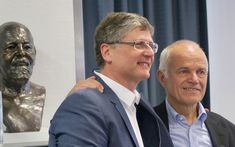Johannes Grillari follows Heinz Redl
At the Ludwig Boltzmann Institute for Experimental and Clinical Traumatology (LBI Trauma), central trauma research institution of the AUVA, research is all about improving patient care following traumatic injuries. Whether it is about hemostasis after severe trauma, the development of new diagnostic tool or regeneration of damaged tissue – discoveries made here are finding their way into trauma clinics in Austria and worldwide.
BOKU and LBI Trauma have collaborated in many projects over the years. Both institutions are members of the Platform for Advanced Cellular Therapies (PACT) and the Austrian Cluster for Tissue Regeneration – practicing the motto “Art is I, Science is we”, a quote by Claude Bernard that can be found at the entrance to the LBI Trauma. Now there is one more connection: after 20 years as head of LBI Trauma, Heinz Redl stepped down from this position, to which Johannes Grillari was now appointed, and took over beginning of April. Johannes Grillari is already in charge of the Christian Doppler Laboratory for Aging Research at the Department of Biotechnology (DBT) at the BOKU, where he also acts as an associate professor since 2010.
With more than 550 publications and 26.000 citations, numerous awards and the EU chairmanship of the Tissue Engineering and Regenerative Medicine International Society, Redl has set the bar high for his successor. Johannes Grillari is well prepared to follow in his footsteps. He already plays a leading role in the field of extracellular vesicles, which recently drew great attention due to their role in cell-cell communication. In 2010, Grillari and his team were the first to discover the role of circulating miRNAs for the prognosis of age-associated diseases.
Grillari has cooperated with the LBI Trauma in numerous projects, such as determining the role of miRNAs in stem cell based therapies or extracorporeal shockwave treatment. The first joint publication already took place in 2009 and described the development of an immortalized cell line from adipose-derived stromal/stem cells. Today the cell line serves as a model system in many laboratories. In the future it could also be used for the production of extracellular vesicles for the treatment of various diseases.
There is another quote at the door to the LBI trauma office: “Who wants to discover truly new thing, cannot be crazy enough. (Niels Bohr)” Unconventional approaches such as silk-made ligaments or nature-derived biocompatible glues demonstrate that scientists at the LBI Trauma embrace this mindset. Johannes Grillari has already proven that he can be just as crazy, most noticeably when, together with his wife Regina Grillari – also an internationally renowned scientist at the DBT and BOKU and currently working at Evercyte GmbH, a company she co-founded – they established the use of urine as source for induced pluripotent stem cells. This non-invasive method could become a new standard of gaining cells for tissue regeneration and implant generation.

